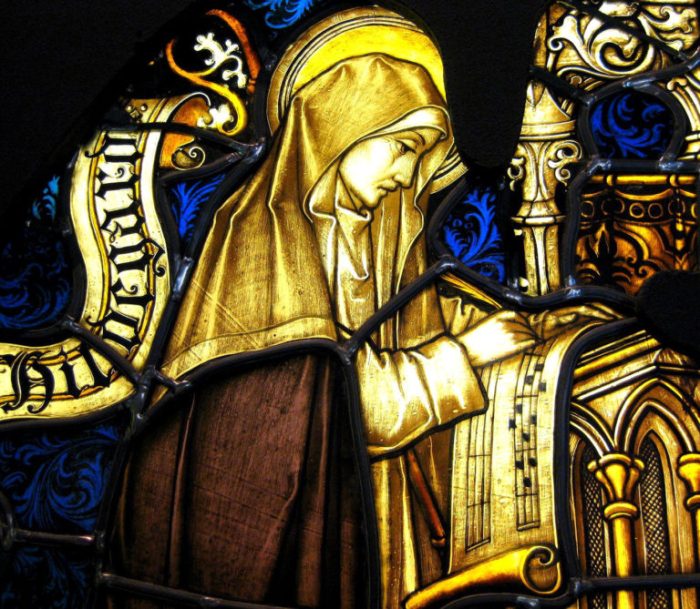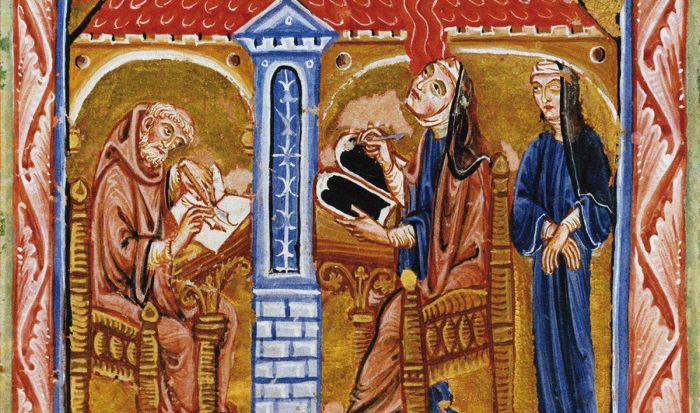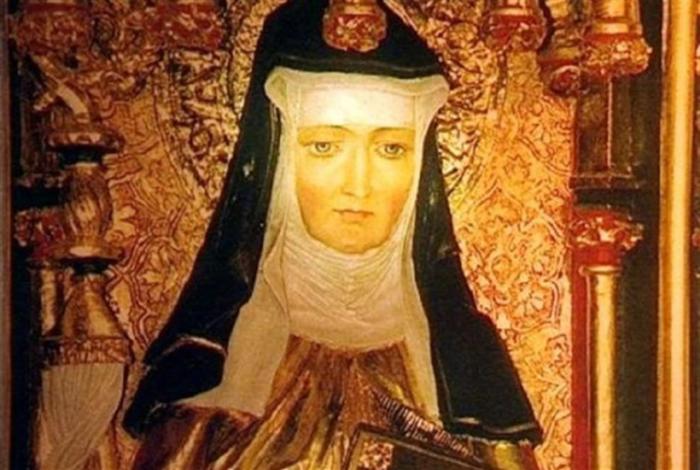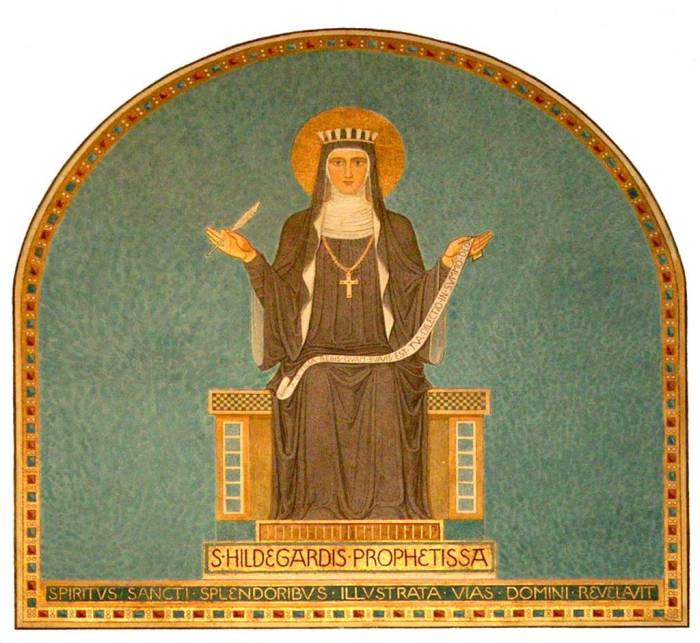Hildegard von bingen was apex – Hildegard von Bingen, a visionary and polymath of the Middle Ages, left an enduring legacy that continues to captivate and inspire. From her profound spiritual insights to her groundbreaking medical practices and musical compositions, Hildegard’s influence permeated every aspect of medieval society and beyond.
This exploration of Hildegard von Bingen’s multifaceted brilliance will delve into her mystical experiences, medical knowledge, musical artistry, and lasting impact on Western culture, offering a comprehensive understanding of her extraordinary contributions.
Hildegard von Bingen’s Spiritual and Philosophical Beliefs

Hildegard von Bingen was a visionary mystic who experienced profound spiritual encounters throughout her life. Her visions and mystical experiences shaped her understanding of the divine, the natural world, and the human soul.
Mystical Experiences and Visions
Hildegard experienced vivid visions from a young age, which she described as “living lights” and “a fiery mind.” These visions often depicted biblical scenes and allegorical representations of the divine. Hildegard believed that her visions were a direct connection to the divine, and she recorded her experiences in her writings.
Understanding of the Divine and the Natural World
Hildegard’s visions led her to develop a unique understanding of the divine and the natural world. She believed that all creation was interconnected and that the divine was present in all things. She saw the natural world as a reflection of the divine, and she believed that humans had a responsibility to live in harmony with nature.
Writings on Cosmology, Anthropology, and the Soul
Hildegard’s spiritual beliefs were expressed in her extensive writings, which covered a wide range of topics, including cosmology, anthropology, and the soul. Her writings offer insights into her understanding of the universe, the human condition, and the nature of the divine.
Hildegard von Bingen’s Medical and Scientific Contributions

Hildegard von Bingen was not only a theologian and mystic but also a skilled physician and natural scientist. She possessed a vast knowledge of medicinal herbs, anatomy, and the causes and treatments of illness, which she acquired through her own observations, experiments, and divine visions.
Hildegard believed that illness was caused by an imbalance of the four humors (blood, phlegm, yellow bile, and black bile) and that treatment should focus on restoring balance. She developed a comprehensive system of herbal remedies, which she used to treat a wide range of ailments, from headaches to leprosy.
She also practiced bloodletting, cupping, and other traditional healing techniques.
Herbal Remedies
Hildegard’s herbal remedies were based on her belief in the healing power of nature. She believed that each plant had its own unique properties and that these properties could be used to treat specific illnesses. Some of her most famous herbal remedies include:
- Galangal root: Used to treat digestive problems, colds, and flu.
- Fennel seed: Used to improve digestion, reduce gas, and relieve colic.
- Mugwort: Used to treat menstrual cramps, headaches, and anxiety.
- Nettle: Used to purify the blood, reduce inflammation, and boost the immune system.
- Yarrow: Used to stop bleeding, heal wounds, and reduce inflammation.
Hildegard von Bingen’s Musical Compositions

Hildegard von Bingen was not only a mystic and a visionary but also a gifted musician. Her musical compositions, characterized by their ethereal melodies and profound spiritual themes, have captivated listeners for centuries.
Characteristics of Hildegard’s Musical Style, Hildegard von bingen was apex
Hildegard’s music is known for its:
- Monophonic melodies:Her compositions typically consist of a single melodic line, accompanied by occasional drones or simple harmonies.
- Melismatic style:Hildegard often employed long, flowing melismas, in which a single syllable is sung over multiple notes.
- Use of modal scales:Her music is primarily based on the medieval modes, which create a sense of otherworldly and mystical atmosphere.
- Improvisational elements:While Hildegard’s compositions were written down, there is evidence that she also incorporated improvisational elements into her performances.
Themes and Symbolism in Her Compositions
Hildegard’s musical compositions often explored spiritual and philosophical themes, including:
- Love of God:Many of her songs express her deep devotion and love for the divine.
- The natural world:Hildegard’s music frequently incorporates imagery and symbolism from the natural world, reflecting her belief in the interconnectedness of all things.
- The human body:Her compositions sometimes contain anatomical references, suggesting her understanding of the human body and its connection to the spiritual realm.
- The apocalypse:Hildegard’s music also addresses themes of judgment and the end of the world, reflecting her apocalyptic visions.
Famous Works
Some of Hildegard von Bingen’s most famous musical works include:
- Ordo Virtutum (Play of the Virtues):A musical drama that explores the struggle between good and evil.
- Symphonia Harmoniae Caelestium Revelationum (Symphony of the Harmony of Celestial Revelations):A collection of 77 songs that set her visions to music.
- O Euchari:A hymn to the Eucharist, known for its beautiful and haunting melody.
Hildegard von Bingen’s Influence on Medieval Society

Hildegard von Bingen was a prominent figure in medieval society, leaving a profound impact on religious thought, art, literature, and music. Her visionary and spiritual leadership inspired many, shaping the cultural landscape of her time.
Hildegard von Bingen was an influential figure in the 12th century, known for her writings on medicine, music, and spirituality. Her ideas were groundbreaking and had a lasting impact on Western thought. For instance, her treatise on herbal medicine, Physica, contained detailed descriptions of plants and their medicinal properties.
This pioneering work laid the foundation for modern herbalism. Similarly, her understanding of mathematics and geometry can be seen in the graphs she created , which displayed a remarkable grasp of the subject. Hildegard von Bingen’s legacy as an intellectual and spiritual leader continues to inspire scholars and practitioners today.
Religious Thought and Practices
Hildegard’s writings on theology and spirituality influenced religious thought and practices in medieval Europe. Her visions and mystical experiences provided a unique perspective on Christianity, emphasizing the importance of divine revelation and the interconnectedness of all creation.
- Her book “Scivias” presented a comprehensive vision of the cosmos, outlining the history of salvation and the role of humans in God’s plan.
- Her emphasis on the feminine aspects of God and the role of women in the Church challenged traditional gender roles and opened new avenues for female spirituality.
Art and Literature
Hildegard’s influence extended to the realms of art and literature. Her vivid visions and symbolic language inspired medieval artists to create illuminated manuscripts, paintings, and sculptures that depicted her spiritual experiences.
- Her writings provided a rich source of inspiration for medieval poets and writers, who drew upon her imagery and spiritual insights in their own works.
- Her musical compositions, such as “Ordo Virtutum,” showcased her unique blending of spirituality and artistic expression.
Hildegard von Bingen’s Legacy and Modern-Day Significance

Hildegard von Bingen’s multifaceted contributions left an indelible mark on Western culture. Her writings, music, and scientific advancements continue to inspire and inform modern-day scholarship and practice.
As a pioneer in medicine, science, and music, Hildegard’s legacy extends far beyond her time. Her medical treatises, including “Physica” and “Causae et Curae,” provided a comprehensive understanding of human anatomy and physiology, paving the way for advancements in healthcare.
Medical Legacy
Hildegard’s holistic approach to healing emphasized the connection between mind, body, and spirit. She believed in the therapeutic power of music, herbs, and natural remedies, promoting a balanced and harmonious approach to well-being.
- Her writings on herbal medicine and gemstones influenced the development of modern pharmacology and alternative therapies.
- Her insights into the causes and treatment of various ailments, including migraines, digestive disorders, and skin conditions, continue to resonate with modern medical practitioners.
Scientific Legacy
Hildegard’s scientific observations and theories were remarkable for her time. Her writings on natural history, astronomy, and meteorology demonstrated a keen eye for detail and a deep understanding of the natural world.
- Her work on cosmology and the movement of celestial bodies challenged the prevailing beliefs of her era.
- Her observations on the behavior of animals and plants provided valuable insights into the ecological relationships within ecosystems.
Musical Legacy
Hildegard von Bingen was a prolific composer and musician. Her sacred songs and chants, such as “O Virga Jesse” and “Ave Maria,” are still performed and appreciated today.
- Her music is characterized by its haunting melodies, intricate rhythms, and evocative lyrics, expressing her deep spirituality and connection to the divine.
- Her compositions have influenced modern composers, musicians, and performers, inspiring new interpretations and adaptations of her work.
Contemporary Interpretations and Applications
In recent years, there has been a resurgence of interest in Hildegard von Bingen’s work. Her writings and music have been translated into numerous languages, making them accessible to a wider audience.
- Contemporary scholars and practitioners are exploring the applications of her holistic approach to healing, integrating her principles into modern medicine and alternative therapies.
- Musicians and performers are creating new interpretations of her music, blending traditional and contemporary elements to create unique and evocative experiences.
Hildegard von Bingen’s legacy continues to inspire and inform modern-day society. Her pioneering spirit, intellectual curiosity, and unwavering faith remain a testament to the enduring power of human knowledge and creativity.
FAQ Corner: Hildegard Von Bingen Was Apex
Who was Hildegard von Bingen?
Hildegard von Bingen was a German Benedictine abbess, writer, composer, philosopher, mystic, visionary, and polymath who lived in the 12th century.
What were Hildegard von Bingen’s major contributions?
Hildegard von Bingen made significant contributions to spirituality, medicine, music, and literature. She wrote several theological and medical treatises, composed over 70 musical compositions, and was known for her visions and mystical experiences.
Why is Hildegard von Bingen considered an apex figure?
Hildegard von Bingen is considered an apex figure due to her exceptional intellect, diverse talents, and profound influence on medieval society. Her work transcended traditional boundaries and left a lasting legacy that continues to inspire and captivate.